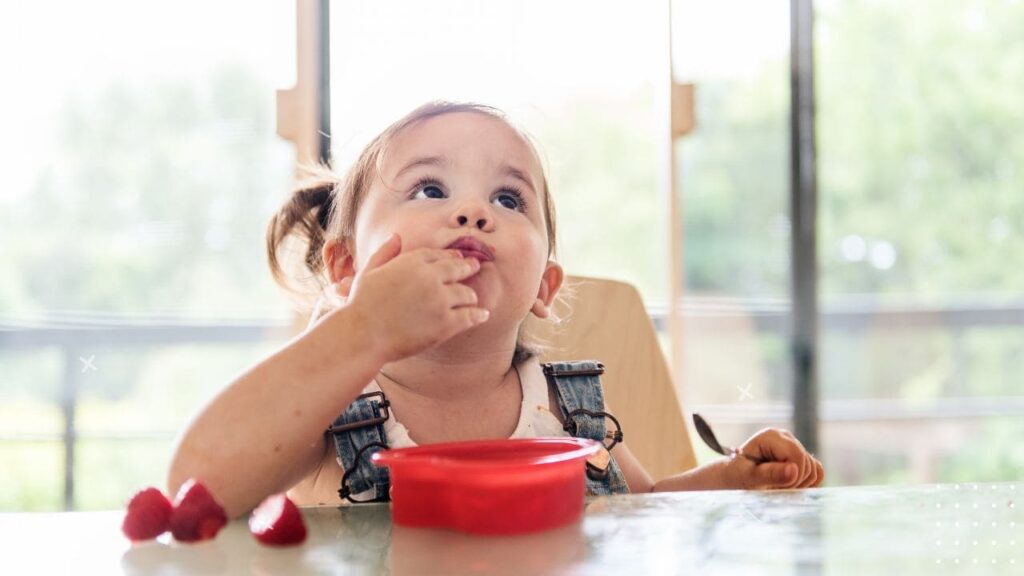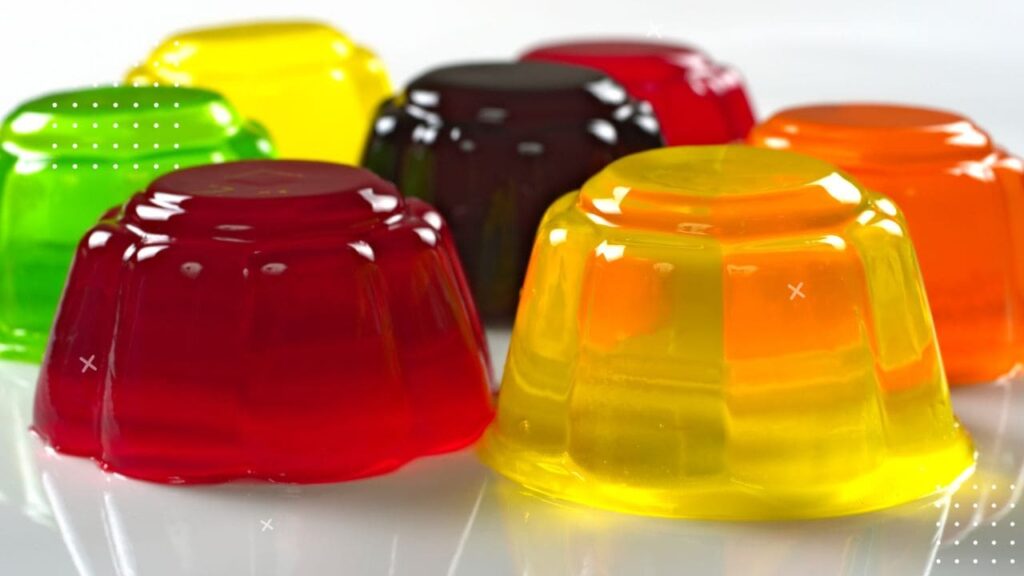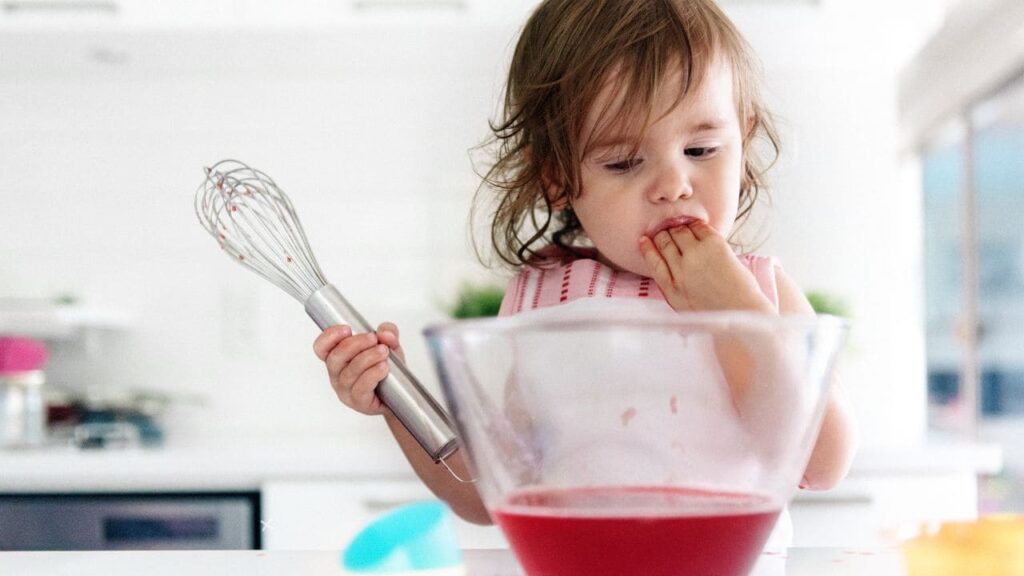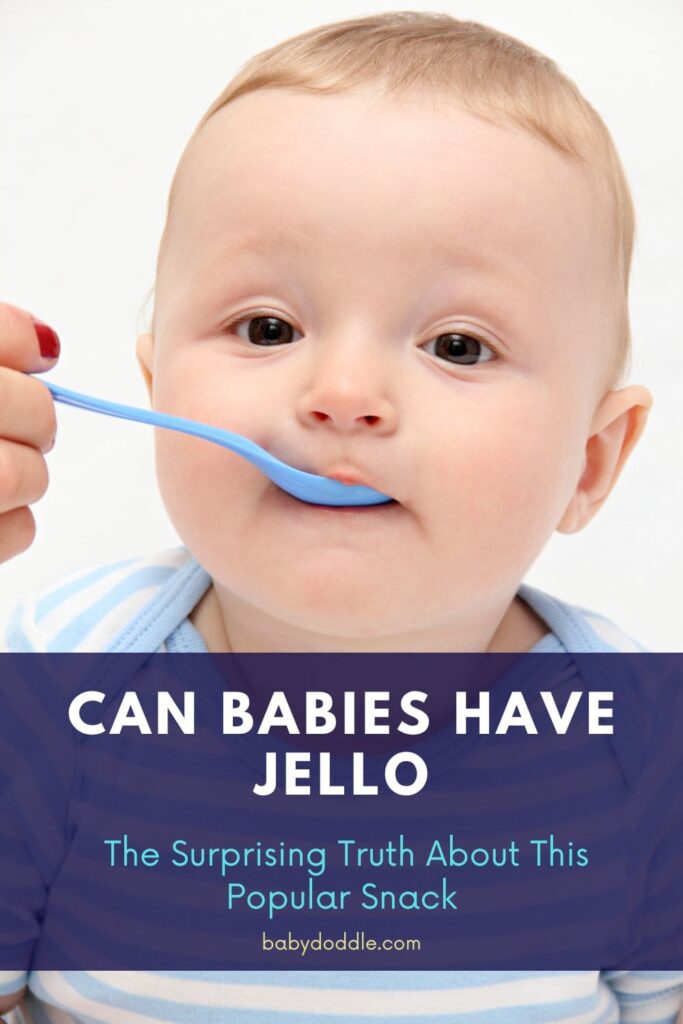Jello is a staple at many family gatherings and parties. It’s sweet, fruity flavor makes it popular with kids and adults alike. As a parent, you may have wondered, “Can babies have jello too or is it unsafe for their little tummies?” It seems like it should be a tasty baby snack for little ones. However, there are some important safety considerations to weigh around introducing jello to infants and toddlers. In this blog post, we’ll take a closer look at whether babies can eat jello, explore healthier jello alternatives to try, rules to follow if you choose to offer it, and more.

What Is Jello and Why Do People Love It?
First, let’s start with what exactly Jello is. Jello is a sweetened gelatin dessert that has a soft, wiggly texture. Gelatin is derived from collagen, a protein obtained from various animal body parts. To make Jello, gelatin powder gets combined with sugar, artificial flavors, and colors. Then fruit juice or another liquid gets added to dissolve the powder and allow it to set into its distinctive gelatinous jiggly form.
There are many reasons Jello became popular and remains a staple treat today:
- It’s fun to eat – both kids and adults enjoy playing with their jiggly food when it’s wobbly and jelly-like!
- The sweet flavors appeal to many people’s tastebuds. Most Americans grow up eating sugary foods.
- It can be prepared quickly and chilled until firm. No lengthy cooking or baking is required!
- Jello offers a huge range of flavors, colors, and possible mix-in additions like fruit or nuts. It’s customizable for different preferences.
- It works well for potlucks and parties since it feeds a lot of people easily. Just throw together a large pan and allow guests to scoop their own servings.
With Jello occupying a place in many family traditions, the big question arises amongst parents – can babies have this sweet wiggly treat too? Let’s explore further.
Detailed nutrition breakdown of jello
Jello is often thought of as just a sweet treat, but examining its nutrition label shows how it stacks up for babies’ needs. A typical 1/2 cup serving of strawberry jello contains:
- 60 calories
- 14g of sugar – more than half of an infant’s daily limit
- No fiber, protein, healthy fats, vitamins or minerals
The lack of fiber, fat, and protein means jello provides almost no satiety or lasting energy for a growing baby. And with zero vitamins or minerals, it does not deliver any nutrition benefits either. The high sugar content can displace healthy foods and drinks in a baby’s diet.
When Can Babies Start to Eat Jello?
The American Academy of Pediatrics (AAP) recommends exclusively breastfeeding or formula-feeding babies until 6 months of age. Foods prior to this should mainly supplement nutrition or practice textures without replacing milk feedings.
Around 6 months, infants’ digestive systems mature enough to start handling some solid foods along with breast milk or formula. But pediatricians caution that Jello itself offers little nutritional value. It contains empty calories from sugar with few vitamins, minerals, fiber or protein compared to the fruits and veggies crucial for growth.
So while technically a 6-month-old baby can eat a tiny taste of jello, it shouldn’t become a dietary staple taking the place of nutrient-rich foods. Between 9-12 months, mashed fruits, vegetables, and healthy proteins should remain the top priority. Consult your pediatrician, but jello likely falls more into the “occasional fun treat” category this early, not a complete meal replacement.
Many health experts recommend waiting until 1-2 years old before purposefully introducing gelatinous jiggly foods like jello. There are good reasons for this guidance.
Tips for making jello extra safe
Jello’s gummy texture poses choking risks. Here are tips to reduce hazards:
- Chill jello firmly so it holds shape when cut
- Use cookie cutters to cut jello into small bites versus cubes
- Freeze jello briefly so it’s easy to gum and dissolves faster
- Mix pieces into soft cooked grains like rice to prevent slipping
- Mash jello with a fork for smoother consistency
- Monitor constantly, keep portions tiny, and stop feeding immediately if any gagging
Taking precautions and adjusting textures makes it possible to share occasional jello treats without causing harm. But risks still exist so supervision is key.
Signs Your Baby is Ready for Solid Foods Like Jello
How do you know if your baby is ready to begin experimenting with solid finger foods like jello? Experts suggest looking for these developmental signs of readiness:
- Good head and neck control
- Ability to sit upright with support
- Loss of tongue-thrust reflex so food can be moved to the back of the mouth
- Improved digestive capacity without spitting up frequently
- Reaching for food or your plate shows interest
- Opening mouth when offered a spoon of food
- Doubled birth weight and weight gain continued steadily
Of course, every baby develops on their own timeline. Consult your pediatrician if unsure about your baby’s readiness. But watching for these feeding milestones means trying that first nibble of jello can soon be within reach!
| Milestone | Description |
|---|---|
| Good head/neck control | Can hold head up steadily |
| Improved digestion | Less frequent spitting up |
| Interest in food | Reaches for food or plates |
| Ability to chew | Moves food around mouth |
| Movement skills | Developing pincer grasp |
Developmental stages of eating and food textures
A baby’s ability to handle foods with different textures changes dramatically between 0-24 months as they gain new skills. Here’s a look at key milestones:
0-4 months: Can only consume liquids like breast milk or formula. No solid foods are recommended.
4-6 months: Smooth, runny purees can be introduced as the baby learns to swallow semi-solid foods.
6-8 months: Mashable foods allow baby to practice chewing motions without teeth.
9-12 months: Finger foods like soft chopped produce, pasta or bread encourage pincer grasp.
12-24 months: Toddlers can chew and swallow a wide variety of textures including diced foods.
Understanding how eating abilities develop helps parents match food consistency with baby’s current developmental stage for safety and success.
Is Regular Store-Bought Jello Actually Safe for Babies to Eat?
While jello seems appealing to little ones discovering new tastes and textures, there are definite safety considerations around babies and toddlers consuming typical sugary store-bought varieties:
Choking HazardsPose Serious Risks
- Jello’s soft but gummy texture differs from the mashed or pureed starter foods infants begin with. Between 6-24 months as children transition to finger foods, gelatin can present a choking risk if swallowed in large pieces. It’s vital to cut jello into very small bites, but its slippery texture still poses some hazards.
Sensitivity Reactions Are Common
- Many jello products contain artificial flavors, food coloring dyes, citric acid, and preservatives. Young digestive systems often react negatively resulting in tummy troubles, skin irritation, or other issues. Consult a pediatrician if your baby experiences discomfort after eating processed foods or chemical ingredients.
Allergies Impact Some Children
Certain children have gelatin allergies or sensitivities just like they can to milk, eggs, nuts or other foods. Reactions vary but may include diarrhea, vomiting, rashes, stuffy nose, or irritation when consuming gelatin. Watch carefully for possible signs of an allergic reaction upon first exposure.
Dietary Imbalances Should Be Avoided
From a nutritional perspective, typical jello poses concerns because of its high sugar content and lack of vitamins and minerals. According to infant feeding guidelines, babies under 2 should avoid added sugars. Too much can lead to excess calories displacing healthy options crucial for growth. This sets the stage for issues like childhood obesity or cavities.

| Baby Age | Food Textures | Choking Risk Level |
|---|---|---|
| 0-6 months | Liquids only | None |
| 6-8 months | Smooth purees | Low |
| 9-12 months | Mashable finger foods | Moderate |
| Over 12 months | Soft hunks, minced | Low |
| 24+ months | Nearly all textures | Low |
Creative ways to boost nutrition of jello
While jello itself offers little nutrition, there are ways to sneak in good-for-you ingredients:
- Use 100% fruit juice instead of artificial flavoring and sweeteners
- Mix in Greek yogurt for protein, calcium, and probiotics
- Add nut or seed butter for healthy fats and vitamin E
- Fold in blended vegetables like spinach or carrots
- Top with fresh fruit slices or berries to add fiber
Getting creative transforms jello into a nourishing snack by incorporating foods from key food groups babies need while keeping the fun jiggle appeal.
Healthier Homemade Jello Alternatives to Introduce First
Clearly, regular sugary jello has some risks for little bellies. But what if parents want to share a cool wiggly baby snack? There are a few safer gelatin options to try first:
Fruit-Sweetened Jello
Skip the extra sweeteners by opting for 100% fruit juice rather than artificial flavors. Heat pure fruit juice like apple or white grape to dissolve plain, unflavored gelatin powder. Refrigerate for that familiar jiggly texture but without dyes or excess sugar. Blend in mashed fruit purees for extra nutrition and flavor!
Chia Seed Pudding
Mix nutrient-dense chia seeds with milk or yogurt to create a tapioca-like healthy treat naturally high in protein, fiber and omega-3s. Chill overnight as the mixture thickens. Spoon into small containers for easy age-appropriate toddler portions. Top with soft sliced bananas, peaches, or other baby-friendly fruits.
Flavored Yogurt Jello
For a protein punch, use Greek yogurt instead of juice to bloom plain gelatin packets. Add yogurt to the dissolved gelatin then mix in pureed fruits like strawberries or mango. Babies get the fun jiggle factor along with a nutritious snack. Using nonfat yogurt keeps calories and sugars low.
These homemade alternatives introduce softer gel textures but are tailored for young palates and infant dietary needs. Always supervise carefully when feeding babies new foods. Stop immediately if your baby dislikes something or shows an allergic reaction. Check with your pediatrician about food introduction concerns.

Rules for Giving Store-Bought Jello to Toddlers
If choosing to offer traditional jello once children reach finger foods age around 1 year old, follow these precautions:
- Select sugar-free or low-sugar varieties only to prevent excess empty calories. But check labels for artificial sweeteners which may cause digestive upset.
- Prep the jello very firm. Then cut pieces no larger than 1⁄4 inch square to reduce choking risks.
- Closely supervise eating to catch any gagging or coughing immediately to avoid dangerous blockages.
- Introduce just 1-2 bites of jello at first. Monitor for 24 hours for reactions before considering second helpings.
- Offer as an occasional dessert, not an everyday food. Focus on hitting all key food groups and nutrition targets instead of the jello itself.
With proper care around the introduction, most babies around 1-year-old can try small tastes of store-bought jello on occasion. However, health organizations stand by recommendations to wait until closer to 2 years old for gelatinous finger foods. By this point, kids have more jaw strength and dexterity to chew properly without choking. Their gut health also improves to handle some processed ingredients as well. Discuss your baby’s timeline with your pediatrician.
Creative Ways to Eat Jello
Plain jello on its own poses risks for babies transitioning to finger foods. But there are creative preparation methods that make enjoying this iconic treat a bit safer:
- Freeze small bites of firm jello for easy grasping and gumming. The cold texture soothes tender gums.
- Mix into a fruit and yogurt smoothie to achieve a creamy, melt-in-your-mouth texture.
- Shape chopped jello pieces into fun designs using tiny cookie cutters.
- String up jello chunks on a pre-gummed baby biscuit for an easy teether snack.
- Stir spoonfuls of jello into bowls of soft cooked grains like rice cereal or oatmeal. The grains prevent slippery sliding.
- Have an aspiring chef help “bake” jello by layering crushed graham crackers into cups before adding jello liquid and chilling.
Getting creative with serving methods can allow for safer jello enjoyment after the first year. But don’t forget the whipped cream on top for parental enjoyment too!
We hope these answers provide clarity for parents wondering “Can babies have” America’s iconic jiggly sweet snack?

Conclusion – Should You Let Your Little One Enjoy Jello?
For parents, jello represents a conflict. Its bright colors captivate children’s attention. And sharing sweet treats you enjoy feels natural. However, its low nutritional value and choking hazard potential leads health experts to exercise caution in fully endorsing it for babies.
Here’s a quick recap about jello for your little one:
- Wait until at least 12 months old, closer to 2 years is preferable.
- Closely supervise eating with small portion sizes to watch for choking or allergies.
- Pick basic fruit flavors and always opt for sugar-free varieties if possible.
- Only offer occasionally as a special treat, not daily food.
- Emphasize a balanced diet of fruits, vegetables, proteins and whole grains.
While some parents may allow tiny portions of jello, a focus on nutrition, safety precautions and balance should drive decisions about baby snacks. When in doubt, consult your pediatrician about the best plan for introducing finger foods like jello to ensure your baby’s health and development stays on track!
Developing Healthy Eating Habits
Beyond questions about when to introduce sweet treats like jello, it’s vital to focus on developing overall healthy eating habits during the transition to solid baby foods between 6-24 months. Pediatricians emphasize getting infants and toddlers accustomed to a diverse, well-balanced diet focused on nutrition. Here’s how:
- Offer new foods frequently, repeating exposures to shape positive associations with Variety
- Model enjoying healthy foods yourself at shared mealtimes
- Minimize snacking between meals so hunger drives interest at mealtime
- Respond sensitively when a baby rejects certain foods but persist gently over time
- Experiment with different textures like smooth purees, soft mashed foods, and smaller pieces
- Focus predominantly on key food groups like vegetables, fruits, whole grains and proteins
- Limit sweets and salty snacks to occasional treats
Starting solid foods invites lots of questions from parents, whether yours is “Can my baby have jello?” or more importantly “How do I shape healthy eating for life?” Focus on the big picture of nutrition, genes and patience with yourself and your baby!
FAQ – Can Babies Have Jello?
Can a 1 month old infant have jello?
No, one month old babies should only have breastmilk or formula. Their immature digestive system cannot handle any solid foods yet.
What about giving jello to a 6 month old baby?
Technically yes, a baby over 6 months can have a tiny taste. But jello provides little nutrition versus crucial baby foods at this age like pureed fruits and vegetables. It also poses choking hazards. Wait until at least 12 months for gelatinous finger foods.
Which jello flavors pose risks for toddlers?
Avoid artificial sweeteners, dyes or excess added sugars. Check labels and select simple flavors made with real fruit juice. Adding your own mashed fruit boosts nutrition.
What are the safest jello varieties for young kids?
Basic flavors like strawberry or peach made with actual fruit juice tend to be gentlest for kids. Adding extra pureed baby fruits amps up nutrients.
Can I mix jello into a baby’s yogurt or puree?
Nutrition experts don’t advise adding unnecessary sugars or thickeners to infants’ meals. Focus instead on establishing healthy eating habits with nutrient-rich baby foods.












